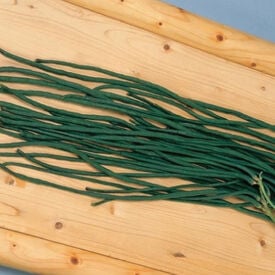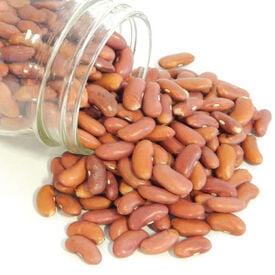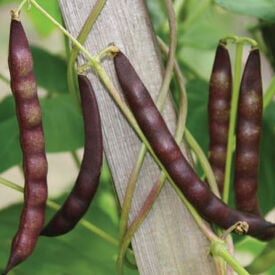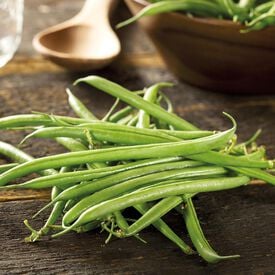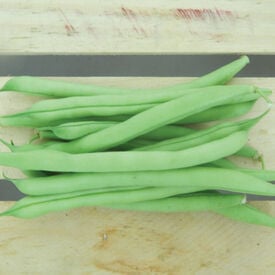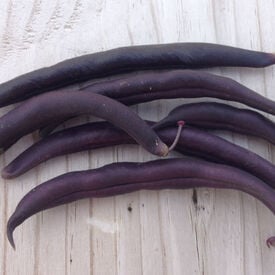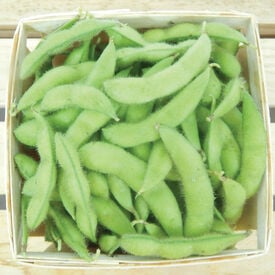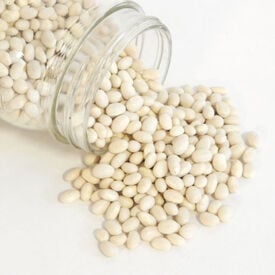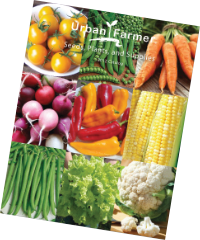Learn More
The Orient Wonder bean is a white seeded yard-long bean with tender pods. This type of pole bean is sometimes called asparagus or yard-long bean. Popular in warm and humid areas, where plants are vigorously vining. Extra-long, slender pods are slow to form seeds, resulting in more tender beans that can be harvested over an extended period. Orient Wonder is popular for specialty and ethnic markets and superior to standard strains due to its ability to set in cooler climates.
The Light Red Kidney Bean is a popular kidney bean that has mild bean flavor! Excellent for chili, bean salads, and soups. Exceptional culinary quality, with silky texture and thin skin. Plants grow to medium size that are sturdy and widely adapted. Produce well anywhere in the United States.
The Black Turtle Soup bean is very popular Latin favorite, that is also great in Cajun and Creole dishes. A tasty variety that grows upright with black beans inside the pod. Tall bush that keeps the bean pods off the ground.
A skinny filet bean with straight and smooth pods. Offers excellent flavor for home gardens and market growers. 5-6" pods that are resistant to anthracnose and bean mosaic virus.
Provider beans are a popular bush bean variety that has garnered attention for its reliable performance and ease of cultivation. Developed in the United States, Provider beans have a rich history dating back to the mid-20th century, when they were bred for both home gardens and commercial production. These beans are characterized by their compact growth habit, typically reaching about 18 to 24 inches in height, which makes them perfect for small spaces and easy to manage without staking. The pods are smooth and a vibrant green color, generally growing to about 5 to 6 inches long. Known for their excellent flavor and crisp texture, Provider beans are ideal for fresh eating, canning, or freezing. Harvesting is best done when the pods are young and firm, usually in mid to late summer, ensuring the best taste and quality. The plants are vigorous and produce high yields, demonstrating good resistance to common diseases. With their dependable growth, delightful flavor, and adaptability, Provider beans remain a favorite choice for both novice and experienced gardeners.
The Vermont Cranberry Shell bean is an incredible bean variety that can be used as a snap, shell or dry bean. Cranberry Shell stores exceptionally well. Maroon colored beans are decorated with darker red, cranberry markings. This variety dates back to the 1800s and is well-suited to short-season, cool summer climates.
Royal Burgundy beans, also known as purple bush beans, are a unique and visually striking variety of Phaseolus vulgaris, the common garden bean. These beans have a rich history dating back centuries, with their origins believed to be in Central and South America, where indigenous peoples cultivated various types of beans. The name "Royal Burgundy" reflects their regal appearance, as the pods and beans are a deep, royal purple color. They gained popularity in the United States during the 1980s and have since become a favorite among gardeners and culinary enthusiasts alike. In terms of taste, Royal Burgundy beans offer a mild, slightly nutty flavor that is reminiscent of traditional green beans. However, their vibrant purple color adds a striking visual element to dishes, making them a popular choice for salads and garnishes. The pods are typically around 4-6 inches in length and are harvested when they are young and tender, before the seeds inside fully develop. Royal Burgundy bean plants are compact and bushy in nature, making them well-suited for smaller gardens and containers. They typically reach a height of about 18-24 inches. These beans are known for their relatively quick maturity, with most varieties ready for harvest in approximately 50-60 days after planting. Their vibrant purple color is not only appealing but also serves as a natural indicator of freshness. Royal Burgundy beans exhibit good resistance to common bean diseases such as bean mosaic virus and rust. When properly cared for, these plants can yield a bountiful harvest. Yields can vary, but on average, you can expect a productive harvest of 2-3 pounds of beans per plant. Plant spacing should be around 2-4 inches apart in rows that are spaced about 18-24 inches apart. They thrive in well-drained soil with full sun exposure and regular watering, making them a relatively easy and rewarding addition to any vegetable garden.
A gourmet, dwarf French filet bean well suited for container gardens or rows. Cooks appreciate the elegance of these petite, slim beans of consistent quality. Considered one of the best flavored beans that stay tender for several days after harvest. Suitable for small space gardens.
Tendergreen Improved is one of the highest yielding beans around. The Tendergreen Improved bean plant is a widely adapted home garden variety. These bean plants will produce some of the highest bean yields you'll ever see. Best eaten fresh.
Midori Giant is a traditional edamame variety that is eaten in oriental food. Midori Giant is an early maturing soybean with very large pods. Consistent heavy producer with over 90% two and three-seeded pods. Adaptable to all regions of the USA.
The great northern bean is an heirloom bean variety that is perfect for drying and using in different baked dishes. Semi-vining, 24 inch plants yield a prolific quantity of flat, 5 inch pods holding 5 to 6, large white beans.
Navy beans, scientifically known as Phaseolus vulgaris, are small, oval-shaped beans that are a popular and versatile member of the legume family. They are often referred to as navy beans due to their association with the United States Navy, where they were a staple food for sailors in the 19th century. These beans have a rich history dating back to ancient times when they were cultivated by indigenous peoples in the Americas. They were later introduced to Europe by Spanish explorers and became an essential part of global cuisine. Navy beans have a mild, nutty flavor and a smooth, creamy texture when cooked. They are known for their ability to absorb the flavors of the ingredients they are cooked with, making them a favorite in soups, stews, and baked bean dishes. These beans are typically small, about half an inch in length, and are usually white or off-white in color, although there are variations with speckled or colored coats. In terms of plant characteristics, navy bean plants are relatively compact, reaching a height of about 18 to 24 inches. They have a bushy growth habit and produce small, white or lavender flowers before developing pods that contain the beans. Navy beans typically take around 80 to 90 days to reach maturity, making them a relatively quick-growing crop. They thrive in well-drained soil with good moisture retention and prefer full sun for optimal growth. Adequate spacing and support may be needed to ensure healthy plant development, and they are generally grown as annuals in most regions.
